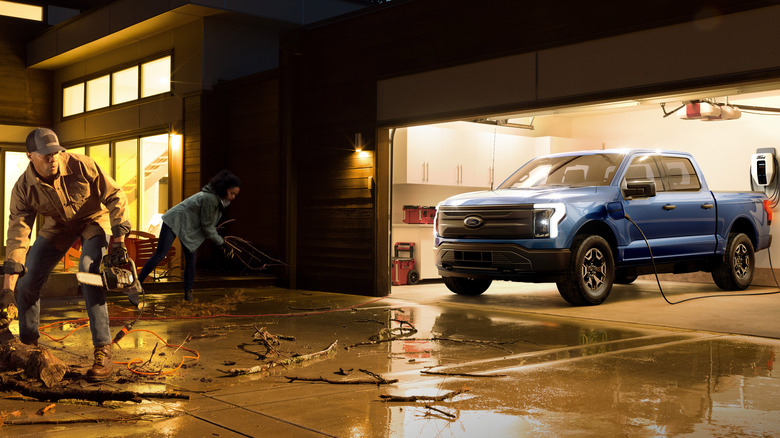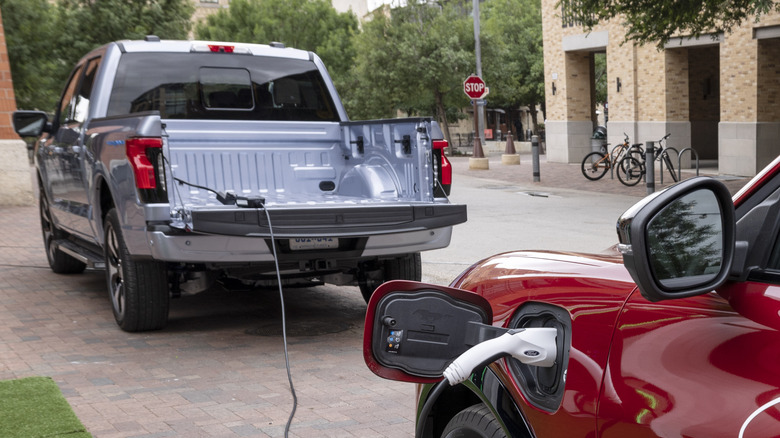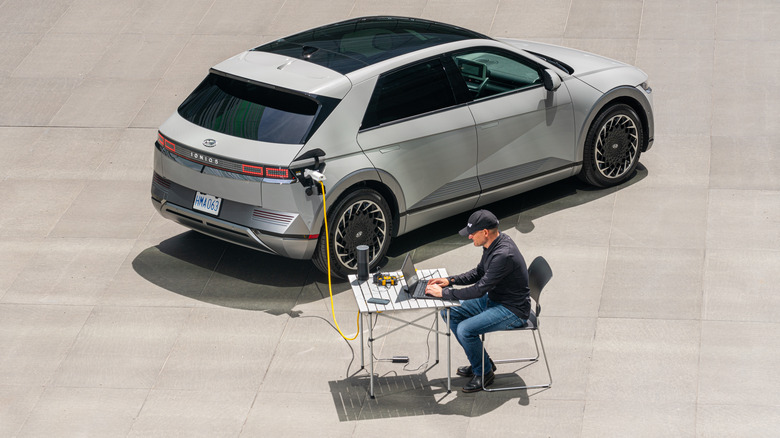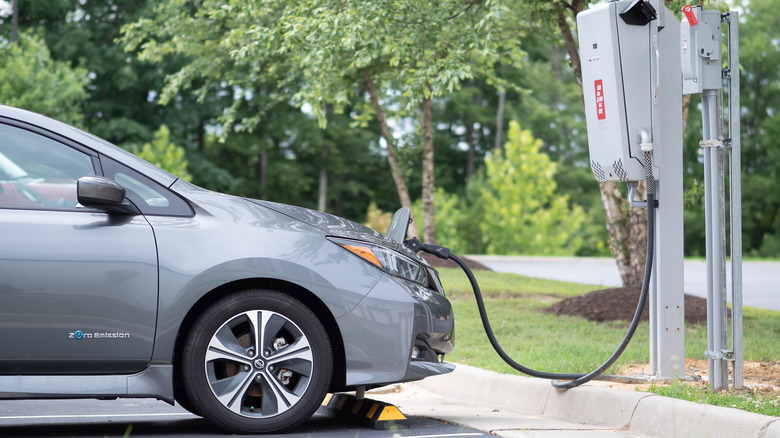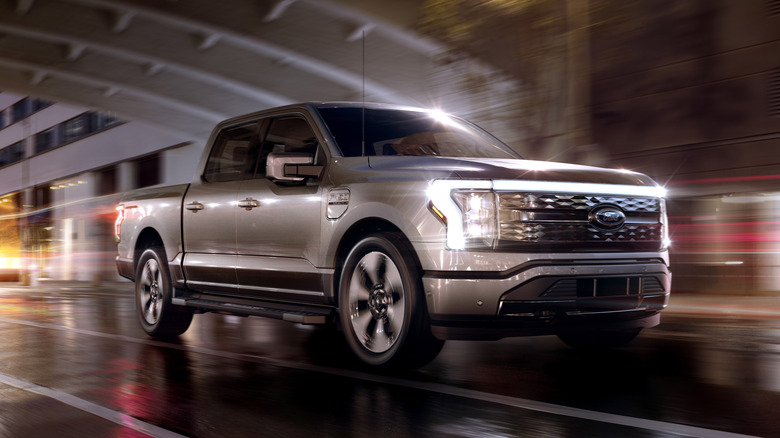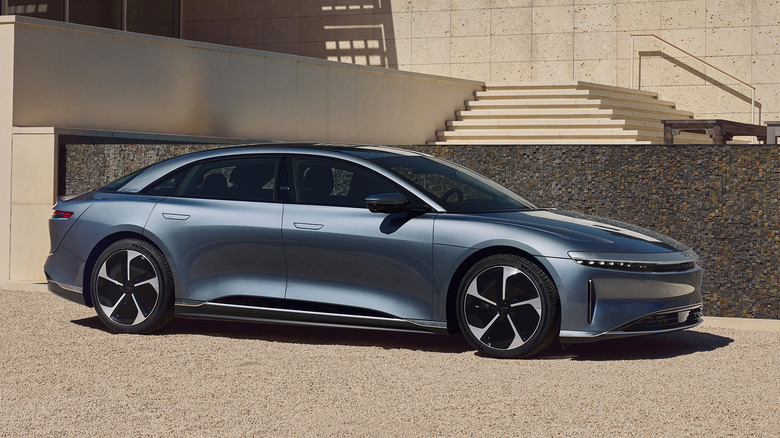How Your EV Could Save The Day When Winter Outages Strike
When you think of vehicles that are rugged and handy in a crisis, it's fair to say that EVs may not be the first things that spring to mind. Many people opt to have a proven utility vehicle by their side for the times when things take a turn for the worse. Cars like the unflappable Jeep Wrangler are ideal for traversing bad road conditions – or bypassing the road entirely – but what if you're stuck at home? It's in this scenario where electric vehicles are revealing themselves to be useful beyond simply skipping the pump.
With winter storms and blizzards settling in for a spell across the United States, there's a good chance the power will be knocked out while we hunker down in our houses. And for all the talk about charging an EV at home, wouldn't it be nice if they returned the favor once in a while? Thanks to bidirectional charging, it can happen, and the timing couldn't be better. This technology isn't widespread, but here are a few EVs that can be useful in a pinch once your particular section of the grid drops.
Bidirectional charging
Let's first talk about what bidirectional charging is and its current forms. In short, standard EV charging is a one-way street, where an alternating current is converted into a direct current and fed to the battery. As the name suggests, bidirectional charging converts this stored energy back into an alternating current and sends it back to the grid. That's vehicle-to-grid charging or "V2G" for short. One car giving back to the grid won't make a big difference but several can, acting as reserves during peak usage hours and then having that power returned during usage is lower and cheaper.
Another form of bidirectional charging is V2H, or vehicle-to-home, which means the car in question has the ability to connect to a house and act as its battery. In daily usage, it can supplement a house's electricity needs and then recharge during low-cost utility rate hours. In a pinch, it can power an entire home for a limited amount of time.
V2L or vehicle-to-load is currently (no pun intended) the most common and easier to achieve version of bidirectional charging. This means the EV in question has the ability to power appliances — like a refrigerator — if need be, though is not necessarily equipped to keep a whole home's electrical circuit running.
V2L: Hyundai Ioniq 5
At the moment, the EVs capable of bidirectional charging are few and far in-between. Depending on the use case, some are also better than others. The Hyundai Ioniq 5, for example, is equipped with a charging control unit that can provide up to 3.6 kilowatts of power. There is an internal outlet and an external one. The external is handy when it comes to larger items like an air conditioner, but it can also power essential camping gear if someone has taken it with them out into the wilderness.
Kia says it can power a 55-inch TV for 24 hours, should your power demands revolve around binge-watching during a blackout. There are worse ways to kill time in a crisis, I suppose. Either way, while the Ioniq 5 or any vehicle it shares a platform with — like the Kia EV6 and Genesis GV60 — can't charge a whole home, it can handle individual items and all you would need is an extension cord.
V2G: Nissan Leaf
Earlier this year, Nissan approved a bidirectional charger from Fermata Energy for use with its city EV runabout, the Nissan Leaf. With this converter, the Leaf's battery can be used to supply energy to the grid, which opens up the possibilities for utility savings if and when this function becomes commercially available. As it stands, the Leaf's V2G charging system is meant for businesses that manage a fleet of vehicles. Those who do can reduce the costs of vehicle ownership, and can even have their office building supplied energy by its fleet if the power goes down.
This application is a sort of microcosm of what V2G usage would look like if it was adopted by multiple users in a particular region. Could a Leaf power a house on its own? No, but if the neighborhood was full of EV users giving back to the grid, the collective could mitigate or prevent blackouts during an outage. Imagine: several Leafs working together to gather power. Yes, you're thinking of a tree.
Nissan isn't the only automaker exploring V2G. General Motors has a pilot with PG&E to use its electric vehicles as backup supplies in select California locations, and Ford is also getting in on the trials. Of course, we'll have to wait a while to see V2G roll out more broadly.
V2H: Ford F-150 Lightning
A Leaf might not be enough to power a house but it's nothing compared to harnessing the lightning, specifically the Ford F-150 Lightning, the blue oval's first all-electric pickup truck. Using an 80-amp Ford charging station integrated into a home unit, the F-150 can produce up to 9.6 kW of power should the need arise. Using the Lightning's juice, Ford predicts it can power a home for three days, or 30 kWh per day, which can be stretched to 10 days if the power is rationed.
Those without the home integration kit — or who find themselves with the Lightning elsewhere that power is needed — can use the F-150 as a mobile generator through the 240V outlet located in the truck bed. In fact, the Lightning is designed to be a versatile tool just as much as the rest of the F-150 lineup, with a total of 10 120V outlets available as well to power tools, appliances and entertainment devices.
The benefits of the Lightning extend beyond just the power it generates for other devices. As an F-150, it's capable of all the utility that makes Ford's truck line the best selling vehicle in America year after year. So, in case of a calamity, it has terrain-tackling talents and the cargo capacity to take supplies to and from a situation if need be. In other words, it's the EV you'd probably want the most in a crisis.
Power in a pinch
Just as electric vehicles have been becoming mainstream, so too will bidirectional charging become normalized in the near future. It may be niche now, but its potential in both normal to emergency situations will surely make it a high-demand function for most, if not all, future EVs. This is particularly likely if/when EVs become the majority of vehicles on the road. The fact that our infrastructure isn't equipped to handle that future just yet is no secret, and V2G charging will likely become a requirement of EV ownership, if only to help maintain a power grid's stability.
What else can V2X technology bring us? Well, support for other vehicles is the one application we haven't touched on. Bringing power to a stranded EV by way of another EV would likely be another solution that could potentially be life-saving. Imagine being stuck in an EV with no juice, and without a suitable charger in reach. Instead of calling in an expensive flat bed to haul the weighty EV away, another electric car could swing by and top it off, sharing enough of its power to get its fellow EV back on the road. Lucid has expressed the possibility of giving its luxury sedan, the Air, that capability.
Just as having a battery pack for your phone or a box of AAs handy, having an EV and access to its massive stores of power can and will be useful in the event of a storm causing a neighborhood some grief. While some might not physically get you out of trouble, they will give you a leg-up when generators and fuel are scarce, and that's definitely something to consider as you make a shortlist for the next vehicle you want to put in your garage.
